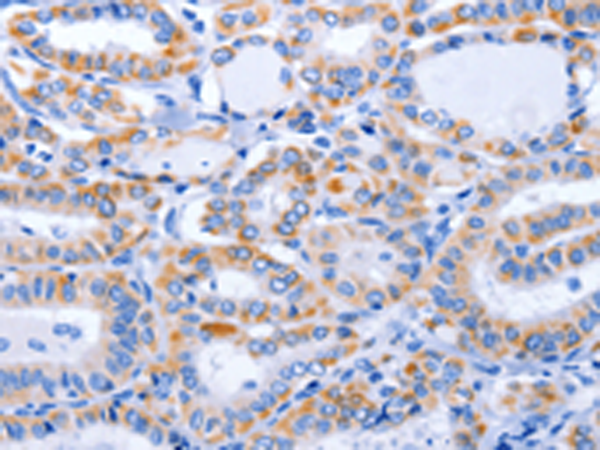

| WB | 咨询技术 | Human,Mouse,Rat |
| IF | 咨询技术 | Human,Mouse,Rat |
| IHC | 1/50-1/200 | Human,Mouse,Rat |
| ICC | 技术咨询 | Human,Mouse,Rat |
| FCM | 咨询技术 | Human,Mouse,Rat |
| Elisa | 1/1000-1/5000 | Human,Mouse,Rat |
| Aliases | ALR, HPO, HSS, ERV1, HPO1, HPO2, HERV1 |
| WB Predicted band size | 23 kDa |
| Host/Isotype | Rabbit IgG |
| Antibody Type | Primary antibody |
| Storage | Store at 4°C short term. Aliquot and store at -20°C long term. Avoid freeze/thaw cycles. |
| Species Reactivity | Human, Mouse, Rat |
| Immunogen | Fusion protein of human GFER |
| Formulation | Purified antibody in PBS with 0.05% sodium azide and 50% glycerol. |
+ +
以下是关于GFER抗体的3篇参考文献及其摘要概括:
1. **文献名称**:Augmenter of Liver Regeneration (ALR) Protects Human Hepatocytes Against Apoptosis
**作者**:Polimeno L. et al.
**摘要**:研究通过GFER/ALR抗体检测其在人肝细胞中的表达,发现ALR通过抑制线粒体途径的Caspase激活减少细胞凋亡,提示其在肝脏疾病中的保护作用。
2. **文献名称**:Mitochondrial GFER modulates oxidative stress and cell apoptosis by regulating cytochrome c release
**作者**:Tian Y. et al.
**摘要**:利用GFER特异性抗体证实,GFER敲低导致细胞色素C释放增加,加剧氧化应激诱导的凋亡,揭示了GFER在线粒体氧化还原平衡中的关键调控机制。
3. **文献名称**:Augmenter of Liver Regeneration: A Key Protein in Tissue Repair and Regeneration
**作者**:Gandhi C.R.
**摘要**:综述总结了GFER/ALR抗体在肝再生研究中的应用,强调其在促进肝细胞增殖、抑制纤维化中的作用,并探讨其潜在临床转化价值。
The GFER antibody targets the GFER protein, also known as Augmenter of Liver Regeneration (ALR) or ERV1 homolog, a critical enzyme involved in mitochondrial oxidative protein folding. GFER is evolutionarily conserved and functions as a sulfhydryl oxidase, facilitating the formation of disulfide bonds in substrate proteins alongside Mia40 in the mitochondrial intermembrane space. This process is essential for the assembly of mitochondrial respiratory chain complexes and redox homeostasis.
Initially identified for its role in liver regeneration, GFER has broader implications in cellular proliferation, apoptosis, and mitochondrial dynamics. Dysregulation of GFER is linked to mitochondrial disorders, neurodegenerative diseases, and cancer. For instance, GFER mutations are associated with infantile mitochondrial cardiomyopathy, while its overexpression is observed in certain tumors.
GFER antibodies are vital tools for studying these mechanisms. They enable detection of GFER expression via techniques like Western blot, immunohistochemistry, and immunofluorescence, aiding research into mitochondrial function, disease pathways, and therapeutic targets. Commercial GFER antibodies are typically raised against specific epitopes, often validated for cross-reactivity in human, mouse, and rat models. Recent studies also explore GFER's extracellular roles in inflammation and tissue repair, expanding its relevance beyond mitochondrial biology.
In summary, GFER antibodies provide critical insights into cellular redox regulation, disease mechanisms, and potential interventions targeting mitochondrial dysfunction.
×